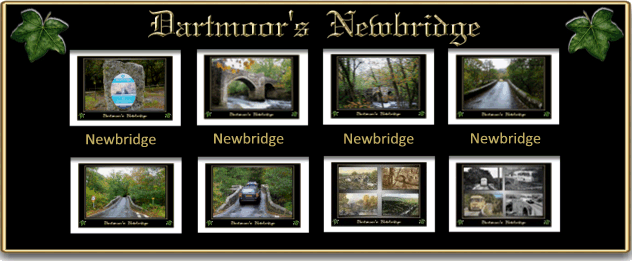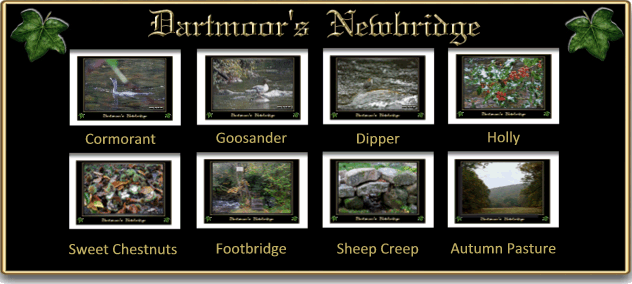
“The bridge is a lovely, picturesque structure, green with ivy, and the river on each side is hedged in with schistose crags and woods,” – T. C. Paris 1865.
Newbridge or Holne New Bridge as it’s sometimes called is thought to date from the fifteenth century, Henderson & Jervoise, p.33, possibly built in 1413. And as the name suggests, to be a ‘new‘ bridge means it had to replace an ‘old‘ bridge which was apparently destroyed sometime previously. Two kilometres downstream of this bridge sits its sibling – ‘Holne Old Bridge’ – which is thought to have been built at roughly the same time. It seems that throughout ttime the bridge has suffered damage of one sort or another. In 1645 Sir Thomas Hare and some fellow judges surveyed the bridge and recorded that they had; “viewed the decayes of the Bridge called Holne New Bridge and ordered the sum of £13 to be raised for necessary repairs,” Hemery, p.37. Since then there are various visible signs of repairs that have taken place down through the ages. The most obvious being the round metal strengthening ‘pins’ that were put in place in 1912. The parapet shows a distinct variation in the granite and its aging and bear witness to past damages.
Newbridge consists of one small arch and two semi-circular arches and is built from granite blocks. There are triangular cutwaters sited both on the up and down stream sides. Their purpose was to reduce the effect of the current as well as providing a safe refuge for foot passengers who met oncoming traffic whilst on the narrow bridge. On the 9th of February 1961 bridge became a grade II* listed structure. The road width of the bridge is a mere 3.04 metres which would have been alright back in the days of horsepower but in more recent times has proved a severe problem.
Since the advent of ‘horseless carriages’ the bridge has struggled to manage the ever increasing burden of these wide vehicles. Due to the picturesque location of the bridge the area around it has grown into a tourist ‘honey pot’ which has increasingly attracted more and more visitors. Over the past 100 years or so the popularity of coach tours and day trips around Dartmoor has grown along with the size of vehicles carrying the passengers. Couple this with the ever-growing numbers of car, caravan and motor-home owners using the bridge and there is a problem
As can be seen below from the early postcards this is not a recent, there is not a lot of room when large vehicles attempt to cross Newbridge. You will also see that there have been some famous vehicles that have encounter difficulties negotiating the river crossing. In the September of 1967 the Beatles were filming their ‘Magical Mystery Tour’ film, part of which was on Dartmoor. Unfortunately the ‘magical tour’ became somewhat of a mystery when the bus got firmly wedged on the bridge.
During the Second World War many parts of Dartmoor were used for military training which involved the movement of troops and vehicles. This posed a problem with regards to the old bridges insomuch as their width simply did not allow the heavy lorries etc to cross. Newbridge was no exception and so to overcome this problem a bailey bridge was constructed across the river at a nearby location.
Every time such events occurred there would be damage of various degrees caused to the bridge and the more serious cases have meant bridge repairs and closures. These in turn have led to traffic congestion or long detours for travellers between Princetown and Ashburton, not to mention repair costs. Over time such incidents grew to such an extent that a traffic order was placed on the bridge preventing any vehicle longer than10 metres long and wider than 2.29 metres from using it. To a certain degree this alleviated the problem but did not completely solve it. In 2005 it was suggested to the various bodies responsible for the bridge that ‘small adjustments’ were made to the parapet. By 2008 nothing had transpired and at a meeting of the Holne Parish Council three further options were proposed. These were to either install width restricting bollards on both sides of the bridge, to install traffic lights or widen and straighten the entire bridge. In 2009 Devon County Council presented the views of English Heritage who as guardians of the Grade II* listing were against any structural alterations. In short they were of the opinion that modern day usage should adapt to the bridge not the bridge adapt to traffic size and volume. Their solution was to adapt non-destructive measures such as improved signage and the tightening of restrictions.

Newbridge features in Eden Phillpotts’ story of ‘Orphan Dinah’ and it was here that she finally came to the decision to tell her foster brother John Bamsley, the water bailiff, that she could not marry him. After the deed was done; “Dinah leant upon the parapet of the bridge and dropped big tears into the crystal Dart beneath her,” p.102.
Having travelled a round trip of three hundred odd miles to get photos of the bridge it made sense to have a bimble despite the Dartmoor drizzle. As I had never visited the area before a quick gander at the OS map showed a nice riverside walk upstream to the footbridge at Wellsfoot Island, crossover and back down the other bank. At least that was the theory, so with that irksome fine drizzle that seems to have the ability to penetrate most waterproofs we (Rhys and I) set off on what was to be an interesting wildlife ramble. Now I always associate Cormorants with the coast, reservoirs and lakes so it was somewhat of a surprise to see one floating nonchalantly down the river Dart. A bit further upstream and we met another bird who was rather camera-shy and rocketed back up the river as soon as we approached. It was not until we got home and Rhys brought over his photographs that there came another puzzle. I freely admit that I am no expert when it comes to bird identification but despite trawler through numerous identification books and surfing various web pages I was unable to put a name to it. Having put the photo on the Legendary Dartmoor Facebook page several replies have stated that it’s a female Goosander which has been living in the area for two years or so. Our next avian encounter came in the form of a dipper who happily stood clinging to a boulder mid-stream, this bird when compared to the last was a right poser and in no hurry to fly away.
All along the track were reminders of autumn and the, I hate to say it, the fast approaching Christmas time. A couple of the holly trees were heavily laden with crimson berries which brightly glistened thanks to the coating of fine raindrops. Images of roaring log fires with mantles dressed with holly and mulled cinnamon wine came flooding to mind. The Christmas theme got a further boost when we cam across a Sweet Chestnut tree that was shedding its bounty creating a carpet of part-opened spiky shells. The only problem being that some person or animal had started Christmas early. There certainly were some excitable squirrels bouncing from tree to tree who it appears had their lunch rudely interrupted.
All through the woods were remnants of past industry and farming in the form of moss covered walls and water channels. One section of old wall had a fine sheep creep embedded in it, these were used to allow sheep to move from field to filed whilst keeping out larger beasts.
Finally we came to the triangular shaped Wellsfoot Island and the footbridge marked on the OS map, one slight problem as can be seen below – it’s private and as the sign said – ‘KEEP OFF’. Additionally if I had studied the map more carefully I would have seen that it only spanned one side of the island – a case of the ‘Six Ps’ – piss poor planning produces poor progress!
So, hey, ho, hey, ho, it’s back the same way we go, but this time along the defined track and not the river bank. On both the outward and homeward journey we noticed a large, weed choked pond with what appeared to be a drainage channel running off it. Again, had the necessary research been previously done it would have been known that in fact this was a lily pond that was constructed sometime in the 1870s. I apologise to the pond for saying it was choked with weed when in fact it was lilies. Locally it is thought that under the pond lies an old mine shaft belonging to what was Devon Great Wheal Elizabeth, a copper mine dating to 1857. Expert opinion suggests that in fact the pond is filled from water running from an old adit associated with the mine. Additionally there is a possibility that under the pond lies the old wheel pit and also the pumping wheel – further information on the mine (either with the wrong grid reference or they have mixed up the information) – HERE.

Despite the rain it was a charming stroll with signs of Autumn everywhere, virtually every berry bearing tree was fully laden with fruits of one kind or another. Some will say that this is a true sign of a forthcoming harsh winter as the wildlife are saving their food for when it will be needed. Others will say that the weather has been so extraordinarily mild that they are still tucking into the summer menu. One thing that is unquestionable is that even in wet weather the Dartmoor russet carpet of bracken along with the bronze, yellow and gold of the trees all lying in a fine mist certainly make for a spectacle.

Hemery, E. 1982. Historic Dart. Newton Abbot: David & Charles.
Henderson, C. & Jervoise, E. 1938. Old Devon Bridges. Exeter: A. Wheaton & Co. Ltd.
Phillpotts, E. 1920. Orphan Dinah. London: William Heinemann.
 Legendary Dartmoor The many aspects past and present of Dartmoor
Legendary Dartmoor The many aspects past and present of Dartmoor
